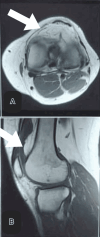Lipoma Arborescens in the Knee Joint
- PMID: 40918794
- PMCID: PMC12411073
- DOI: 10.7759/cureus.89391
Lipoma Arborescens in the Knee Joint
Abstract
Lipoma arborescens (LA) is an unusual and benign lesion found in joints, where one can see villous lipomatous synovial proliferation, with the knee joint being the commonest site. It typically presents with chronic joint swelling and pain. We report the case of a 32-year-old woman with a history of knee trauma three years ago, who presented with progressive pain and swelling in the left knee. Examination revealed swelling with a boggy consistency over the suprapatellar area. There was no joint line tenderness, and the routine clinical tests did not reveal any abnormality. Magnetic resonance imaging indicated synovial proliferation with frond-like synovial mass in the suprapatellar pouch, lateral aspect. Synovial debridement was planned after, which was then performed arthroscopically. Synovial biopsy histopathological examination confirmed the diagnosis of lipoma arborescens. Postoperatively, the patient recovered uneventfully and was able to pursue daily activities without any hindrance. Lipoma arborescens is a rare condition and should be considered in patients with chronic knee swelling and clinical and radiological features suggestive of florid synovitis. Arthroscopic debridement remains an effective treatment.
Keywords: arthroscopic synovectomy; frond-like synovial mass; knee swelling; lipoma arborescens; rare knee tumor.
Copyright © 2025, Kadambila et al.
Conflict of interest statement
Human subjects: Informed consent for treatment and open access publication was obtained or waived by all participants in this study. Conflicts of interest: In compliance with the ICMJE uniform disclosure form, all authors declare the following: Payment/services info: All authors have declared that no financial support was received from any organization for the submitted work. Financial relationships: All authors have declared that they have no financial relationships at present or within the previous three years with any organizations that might have an interest in the submitted work. Other relationships: All authors have declared that there are no other relationships or activities that could appear to have influenced the submitted work.
Figures
References
-
- Lipoma arborescens of the knee. Kloen P, Keel SB, Chandler HP, Geiger RH, Zarins B, Rosenberg AE. J Bone Joint Surg Br. 1998;80:298–301. - PubMed
-
- Lipoma arborescens of the knee: report of three cases and review of the literature. Tsifountoudis I, Kapoutsis D, Tzavellas AN, Kalaitzoglou I, Tsikes A, Gkouvas G. https://doi.org/10.1155/2017/3569512. Case Rep Med. 2017;2017:3569512. - PMC - PubMed
Publication types
LinkOut - more resources
Full Text Sources


